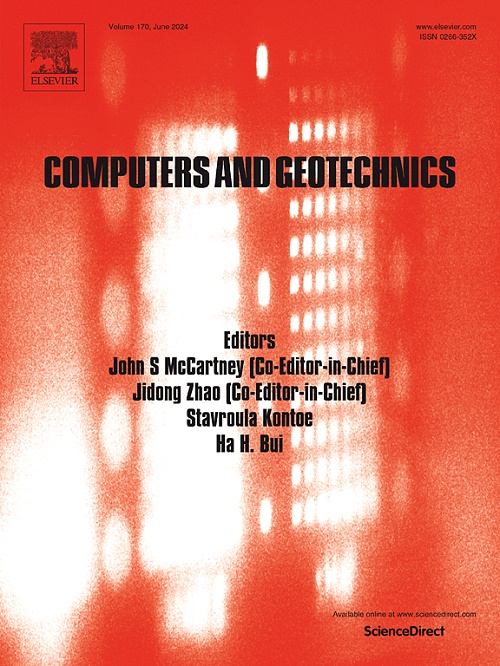A meshless numerical method for optimised design of buried structures in elastic medium
IF 5.3
1区 工程技术
Q1 COMPUTER SCIENCE, INTERDISCIPLINARY APPLICATIONS
引用次数: 0
Abstract
Performance-based design is critical to examine how changes in design parameters influence the safety and stability of the examined structural systems, ensuring optimised performance under varying conditions. Traditional approaches such as finite element method, require careful domain meshing and mesh-sensitivity studies, which are often computationally expensive and, in some cases, mathematically challenging for certain types of problems. Meshless approaches provide efficient and accurate prediction models to address this problem effectively. In this paper, a two-dimensional singular boundary method combined with the method of fundamental solutions is formulated in conjunction with the direct differentiation method to perform design sensitivity-based optimisation of structures embedded in elastic medium under harmonic point loads. The proposed formulation is employed to overcome the non-uniqueness solution problem arising in the singular boundary method when dealing with exterior elastic problems. The accuracy and effectiveness of the proposed approach is assessed in the framework of two analytical examples: a cylindrical cavity subjected to pulsating pressure under Neumann boundary condition and a cavity with a five-cusped hypocycloid boundary under Dirichlet boundary condition. Additionally, the method is assessed in an application of a horseshoe-shaped tunnel embedded in full-space medium and subjected to Neumann boundary conditions. The results indicate that the proposed approach is both accurate and robust for performing sensitivity analysis on complex geometries in elastic media, particularly when compared to the classical singular boundary method. Furthermore, the application case study demonstrates that the method can be effectively used for optimising the shape of underground structures to minimise the impact of geometry on deformations of the surrounding soil. This methodology offers several advantages: it is truly meshless, integration-free, mathematically simple, and easy to implement, providing a valuable tool for decision-making in the design of buried structures within elastic media.
弹性介质中埋地结构优化设计的无网格数值方法
基于性能的设计对于检查设计参数的变化如何影响被检查结构系统的安全性和稳定性至关重要,以确保在不同条件下的优化性能。传统的方法,如有限元法,需要仔细的域网格划分和网格灵敏度研究,这通常是计算昂贵的,在某些情况下,对某些类型的问题具有数学挑战性。无网格方法为有效解决这一问题提供了高效、准确的预测模型。本文提出了一种结合基本解方法的二维奇异边界法,结合直接微分法对弹性介质中嵌入结构在谐波点荷载作用下的设计灵敏度进行优化。该公式克服了奇异边界法在处理外部弹性问题时的非唯一性问题。通过两个分析实例,即在Neumann边界条件下受脉动压力作用的圆柱形腔和在Dirichlet边界条件下具有五尖头次摆线边界的腔,评估了该方法的准确性和有效性。此外,该方法在全空间介质中马蹄形隧道的应用中进行了评估,并受到诺伊曼边界条件的约束。结果表明,与传统的奇异边界法相比,该方法对于弹性介质中复杂几何形状的敏感性分析具有较高的准确性和鲁棒性。此外,应用实例研究表明,该方法可以有效地用于优化地下结构的形状,以尽量减少几何形状对周围土壤变形的影响。这种方法有几个优点:它是真正的无网格,无集成,数学简单,易于实现,为弹性介质中埋地结构的设计决策提供了有价值的工具。
本文章由计算机程序翻译,如有差异,请以英文原文为准。
求助全文
约1分钟内获得全文
求助全文
来源期刊

Computers and Geotechnics
地学-地球科学综合
CiteScore
9.10
自引率
15.10%
发文量
438
审稿时长
45 days
期刊介绍:
The use of computers is firmly established in geotechnical engineering and continues to grow rapidly in both engineering practice and academe. The development of advanced numerical techniques and constitutive modeling, in conjunction with rapid developments in computer hardware, enables problems to be tackled that were unthinkable even a few years ago. Computers and Geotechnics provides an up-to-date reference for engineers and researchers engaged in computer aided analysis and research in geotechnical engineering. The journal is intended for an expeditious dissemination of advanced computer applications across a broad range of geotechnical topics. Contributions on advances in numerical algorithms, computer implementation of new constitutive models and probabilistic methods are especially encouraged.
 求助内容:
求助内容: 应助结果提醒方式:
应助结果提醒方式:


